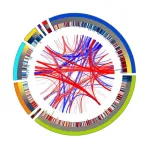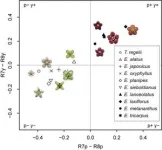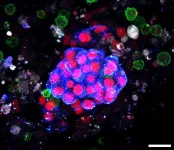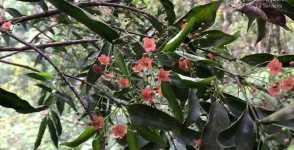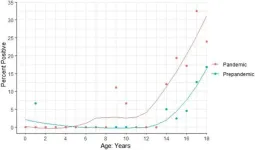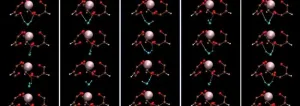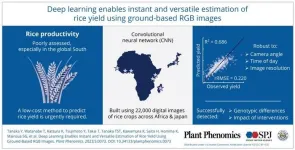(Press-News.org) A study led by researchers at Memorial Sloan Kettering Cancer Center (MSK) and Weill Cornell Medicine discovered a new relationship between cancer cells and the immune system, and shows how cancer can selfishly hijack a normally helpful immune pathway.
Usually, activation of this key immune pathway — called the STING pathway — triggers a strong inflammatory response that protects the body from foreign and unhealthy cells. But prolonged activation of the same pathway leads to a desensitization and ultimately to a “rewiring” of cellular signaling, which aids and abets cancer’s spread, the researchers found.
“You might think of it like a car alarm,” said Dr. Samuel Bakhoum, a researcher and radiation oncologist at MSK, and one of the study’s two senior authors. “If it goes off rarely, that’s going to get your attention. But if it’s going off all the time, you’re going to get used to it and tune it out.”
The findings, which were published Aug. 23 in Nature, help explain why drugs to activate STING (known as STING agonists) have been unsuccessful in clinical trials in patients with advanced cancer, and suggest, counterintuitively, that many patients may actually benefit from drugs that block STING activation (STING inhibitors).
“There’s been millions of dollars invested in drugs that activate the STING pathway to fight cancer, and so far in clinical trials, they have not shown significant anti-cancer efficacy,” Dr. Bakhoum said. “In the lab, these drugs held a lot of promise — but in one trial of 47 patients, there were only two whose cancers even showed a partial response. In another trial of more than 100 patients that combined STING agonists with another immunotherapy, the overall response rate was 10 percent. So the question driving this research was, ‘Why don’t they work despite such promise in the preclinical setting?’”
The team’s discoveries were made possible through the development of an innovative computational tool in the lab of the study’s other senior author, Dr. Ashley Laughney, an assistant professor of physiology and biophysics and member of the Institute for Computational Biomedicine at Weill Cornell Medicine. Dubbed ContactTracing, the approach predicts cell-to-cell interactions and also examines how different cells respond to stimuli in growing tumors. By mapping interactions into a mandala-like pattern, the tool revealed that the long-term activation of the STING pathway leads to changes in cellular signaling that attracts cells that suppress the immune response to the area in and around the tumor.
“This isn’t just another tool to document whether cell type A might interact with cell type B,” said Dr. Laughney, who is also a member of the Sandra and Edward Meyer Cancer Center at Weill Cornell Medicine. “We're looking at whether and how these interactions actually affect the cell receiving the signal.”
The study was led by a team of four co-first authors from the Bakhoum and Laughney laboratories: postdoctoral fellow Dr. Jun Li and senior research technician Mercedes Duran from the Bakhoum Lab; and computational scientist Dr. Melissa Hubisz and Tri-Institutional Computational Biology and Medicine graduate student Ethan Earlie from the Laughney Lab.
When Cell Division Goes Haywire
Central to the research is a phenomenon known as chromosomal instability.
“It’s a feature of cancer, especially advanced cancers, where the normal process of cell division goes haywire,” said Dr. Bakhoum, whose lab is part of the Human Oncology and Pathogenesis Program at MSK.
If the chromosomes are the instruction manual for the body, it’s like having some cells that wind up with a lot of duplicated and/or missing pages, he explains.
“We knew that chromosomal instability is an important driver of cancer’s ability to spread, otherwise known as metastasis,” Dr. Bakhoum said. “What we discovered here is that the immune system plays a central role in this process.”
Cooperation Between Cancer Cells and the Immune System Is Driven by STING
A previous collaboration between researchers at MSK and Weill Cornell Medicine, which was also published in Nature, showed the complex chain of events triggered by chromosomal instability leads to changes in cells that drive cancer metastasis.
“That study was done in partially immune-compromised mice,” Dr. Bakhoum said. “So it was really neither here nor there in terms of understanding the role of the immune system.”
To figure out the immune system’s role, the new study used mouse models of cancer that either had fully functional immune systems or greatly weakened immune systems. It also looked at tumor cells with both high and low levels of chromosomal instability, as well as cells missing the STING1 gene, which makes a protein called STING, that activates an inflammatory response when it detects foreign DNA molecules in the cytoplasm.
“What we found was that the effect was largely dependent on the immune system,” Dr. Bakhoum said. “Basically, there is sinister cooperation between cancer cells with chromosomal instability and immune cells — and that cooperation is driven by STING.”
The results from mouse models of cancer were then validated in healthy cells and tumor samples from human patients.
For example, the researchers treated a simple type of cell, known as a fibroblast, with a STING agonist — the foundation for the drugs developed for human patients — and observed a strong initial immune response.
“But by day five, you have basically no immune response left,” Dr. Bakhoum said. “The cells became desensitized to this pro-inflammatory pathway very quickly — mirroring the response we saw in the cancer cells. Instead, the cells started to signal stress response pathways that dampened the immune response, thus having the opposite effect.”
Digging Into Complex Cell-to-Cell Interactions
The scientists used a technique called single-cell sequencing to understand all the different cellular players in and around a tumor (also called the tumor microenvironment). The technique allows for the detailed analysis of all the many types of cells involved — such as macrophages, T cells, B cells, neutrophils and tumor cells — and the ligands and receptors they express. Notably, to communicate, cells typically emit ligands that bind to complementary receptors on the surface of target cells, thereby triggering a change in the behavior of the target cell. While most methods predict cell-to-cell interactions based on just the mutual expression of complementary ligand-receptor pairs, the research team focused on whether their interaction actually changes the cell receiving the signal.
“One of our most important findings was that altering the level of chromosomal instability or the activation of STING dramatically changes responses in the environment in and around the tumor,” Dr. Laughney said.
And to understand those impactful interactions between the cancer cells and different immune cells, the researchers developed ContactTracing. By design, the tool exploits the variability of real-world biology without the need for prior knowledge.
The method is based on the simple premise that in a given tumor, there is inherent biological diversity — not every cancer cell is going to secrete the same binding molecule, or ligand. And not every immune cell is going to express the right receptor for that ligand, Dr. Laughney explained.
So, by comparing cells that are interacting to ones that aren’t, the tool gives scientists a clearer picture of what exactly is changed by the interaction between the two.
“When you look at the effects that elicit a response in the cancer microenvironment, all the ligands on those chromosomally unstable cancer cells were associated with a specific cellular stress response — one that happens to involve STING,” she said.
And when the same interactions were examined in the context of low chromosomal instability or where STING had been depleted from cancer cells, they trigger a different response — a strong immune response that attacked the cancer cells.
The new ContactTracing method could also help illuminate other areas of biology and disease where cell-to-cell interactions are critical, Dr. Laughney noted.
Findings Suggest Therapeutic Opportunities
The findings from the study suggest an opportunity to improve treatments for the many patients with advanced cancer driven by chromosomal instability, Dr. Bakhoum said.
“It appears the reason activating STING in these patients isn’t very effective is that most patients’ cells are already desensitized to it due to the persistent activation of the pathway from chromosomal instability,” he said. “Counterintuitively, these patients may actually benefit from STING inhibition.”
Treatment of study mice with STING inhibitors reduced chromosomal instability-driven metastasis in melanoma, breast, and colorectal cancer models.
Additionally, by identifying the subset of patients whose tumors can still mount a strong response to STING activation, doctors could select better candidates for STING agonists, Dr. Bakhoum said.
Additional Authors, Funding, and Disclosures
Additional authors on the study include Julie-Ann Cavallo, Christy Hong, Atif J. Khan, Emanuele Lettera, Simon Powell, Jorge S. Reis-Filho, and Hannah Wen, of MSK. Karolina Budre, Matthew Deyell, Erina Kamiya, and Austin A. Varela, of Weill Cornell Medicine. Sarah Bettigole, Jonathan J. Havel, and Bernardo Tavora, of Volastra Therapeutics. Eileen E. Parkes and Su M. Phyu, of Oxford University. Amit Dipak Amin and Benjamin Izar, of Columbia University. And Christopher Garris, of Harvard University.
The study was supported by the National Institutes of Health and National Cancer Institute (P50CA247749, DP5OD026395, R01CA256188, P30-CA008748, R01CA256188, R01CA280414, R01CA280572, U01CA210152, R21-CA266660, R37CA258829, R21CA263381, R01CA280414, R01CA266446, P50CA247749); Congressionally Directed Medical Research Program (BC201053); the Burroughs Wellcome Fund; the Josie Robertson Foundation; the Cycle for Survival Fund; a Kellen Junior Faculty Award; the Melanoma Research Alliance; the Lung Cancer Research Foundation; the Pershing Square Sohn Cancer Research Alliance; the Tara Miller Melanoma Research Alliance; the V Foundation; the Oxford Institute for Radiation Oncology; the Prostate Cancer Foundation; the Wellcome Trust; the American Society of Clinical Oncology; the Academy of Medical Sciences; the Breast Cancer Research Foundation; a Susan G. Komen Leadership Grant; and a STARR Cancer Consortium grant.
Dr. Bakhoum holds a patent related to some of the work targeting chromosomal instability and the STING pathway in advanced cancer. He owns equity in, receives compensation from, serves as a consultant for, and serves on the Scientific Advisory Board and Board of Directors of Volastra Therapeutics, and he serves on the Scientific Advisory Board of Meliora Therapeutics.
Dr. Parkes, Dr. Izard, Dr. Wen, Dr. Reis-Filho, and Dr. Garris disclosed ties to the pharmaceutical and/or finance industries. Dr. Bettigole, Dr. Havel, and Dr. Tavora are employees of Volastra Therapeutics and own equity in the company.
END
New research shows how cancer rewires a key immune pathway to spread
2023-08-23
ELSE PRESS RELEASES FROM THIS DATE:
Graphene discovery could help generate hydrogen cheaply and sustainably
2023-08-23
Researchers from The University of Warwick and the University of Manchester have finally solved the long-standing puzzle of why graphene is so much more permeable to protons than expected by theory.
A decade ago, scientists at The University of Manchester demonstrated that graphene is permeable to protons, nuclei of hydrogen atoms.
The unexpected result started a debate in the community because theory predicted that it would take billions of years for a proton to permeate through graphene’s dense crystalline structure. ...
Adding immunity to human kidney-on-a-chip advances cancer drug testing
2023-08-23
By Benjamin Boettner
(Boston) — A growing repertoire of cell and molecule-based immunotherapies is offering patients with indomitable cancers new hope by mobilizing their immune systems against tumor cells. An emerging class of such immunotherapeutics, known as T cell bispecific antibodies (TCBs), are of growing importance with several TCBs that the U.S. Food and Drug Administration (FDA) approved for the treatment of leukemias, lymphomas, and myelomas. These antibody drugs label tumor cells with one of their ends, and attract immune cells with another end to coerce them into tumor cell killing.
One major challenge in the development of TCBs and other immunotherapy ...
Fungus gnats as pollinators not pests
2023-08-23
Many plants and crops rely on insects to pollinate them so they can reproduce. A new study has shown that several flowering plants from the group Euonymus are pollinated by fungus gnats, a dipteran insect. Specifically, they pollinate Euonymus plants which have red-petaled flowers with short stamens and yogurt-like scent. Although fungus gnats are known to pollinate hundreds of plant species, this study shows that the particular traits of red Euonymus flowers were likely to have been acquired via pollination syndrome, evolving over a process of natural selection to be pollinated specifically by fungus gnats. This research highlights the important role of Diptera, which are commonly regarded ...
Solar powered irrigation: a game-changer for small-scale farms in sub-Saharan Africa
2023-08-23
In sub-Saharan Africa 80% of agricultural production is from smallholder farmers, who face constraints on increasing farm productivity resulting in a large yield gap. Extensive rain-fed agriculture (90% of all cropland) under unpredictable and erratic rainfall pattern is a leading cause of the low productivity and food insecurity in Africa, together with a low degree of mechanization. This has been reinforcing a persistent poverty trap, triggered by cyclical famines that are jeopardizing local development opportunities.
In a new IIASA-led study as part of the research project Renewables for African Agriculture (RE4AFAGRI), an international ...
Looking out for kids: a case for better pediatric trauma interventions
2023-08-23
In the weeks following the onset of the COVID-19 pandemic, public health directives called for masking, social distancing, social isolation, and stay-at-home orders. Apart from the severe medical consequences as a direct result of the pandemic, the ensuing social isolation had far-reaching impacts on children. The pandemic control measures affected the pediatric population by increasing mental distress, limiting physical activity, changing sleep patterns, and reducing emergency room visits. Unfortunately, the scope of pediatric trauma during the pandemic remains ...
SwRI investigates the efficiency impact of smart-technology-enabled vehicles
2023-08-23
SAN ANTONIO — August 23, 2023 — A Southwest Research Institute project funded by the U.S. Department of Energy (DOE) has demonstrated an average of 15% energy savings when vehicles outfitted with connected and automated vehicle systems, or CAVs, are introduced into traffic.
CAVs use wireless smart technology to communicate with other CAVs and traffic infrastructure. SwRI’s eco-driving framework uses custom software and predictive powertrain algorithms to enable human drivers to make more efficient driving ...
Nemours Children’s Health researchers to present at World Congress of Pediatric Cardiology and Cardiac Surgery
2023-08-23
JACKSONVILLE, Fla. (August 23, 2023) – Researchers from Nemours Children’s Health will present a range of studies at the World Congress of Pediatric Cardiology and Cardiac Surgery, Aug. 27 – Sept. 1 in Washington D.C., the leading global conference in the field. Nemours Children’s presentations will highlight advances in complex congenital heart disease, prevention, cardiomyopathy in rare diseases, and the benefit of integration with other areas like psychology and telehealth.
"In pediatric cardiac surgery, the Nemours Children’s Cardiac Center has pioneered a number of procedures, and we are pleased to share our new findings with researchers and clinicians ...
Unravelling the water dynamics and structure of water-coordinated metal complexes
2023-08-23
Lanthanide-containing complexes are important compounds for sophisticated nuclear-fuel processing and medical imaging. Moreover, they often have interesting symmetric crystal structures and associated dynamics that render unique properties for practical applications.
The seven-coordinate lanthanide complex Ho(III) aqua-tris(dibenzoylmethane) or Ho-(DBM)3·H2O was first reported in the late 1960s. It has a three-fold symmetric structure with holmium (Ho) at the center of three propeller-shaped dibenzoylmethane (DBM) ligands and a water (H2O) ...
Artificial intelligence can now estimate rice yields, according to new study
2023-08-23
With the rise in global demand for staple crop products projected to substantially increase by 2050 due to population growth, rising per capita income, and the growing use of biofuels, it is necessary to adopt sustainable agricultural intensification practices in existing croplands to meet this demand. However, estimation processes currently employed in the global South remain inadequate. Traditional methods like self-reporting and crop cutting have their limitations, and remote sensing technologies are not fully utilized in this context.
However, recent advancements in artificial intelligence and machine learning, particularly deep learning with convolutional ...
NIH/National Institute on Aging’s $3 million R01 Grant supports study evaluating probiotic/prebiotic combination’s impact on maintaining bone health of older women
2023-08-23
The NIH/National Institute on Aging has awarded a R01 $3 million grant to study the impact of a probiotic/prebiotic (synbiotic) medical food developed by Solarea Bio on maintaining bone health of older women.
The study will support an 18-month clinical trial of a synbiotic medical food in 220 older women to test whether it maintains lumbar spine bone mineral density (BMD) with aging.
Grant recipients are Hebrew SeniorLife, USDA HNRCA at Tufts University, Maine Medical Center Research Institute, and Solarea Bio.
“There is an unmet need for safe and effective dietary interventions for the ...
